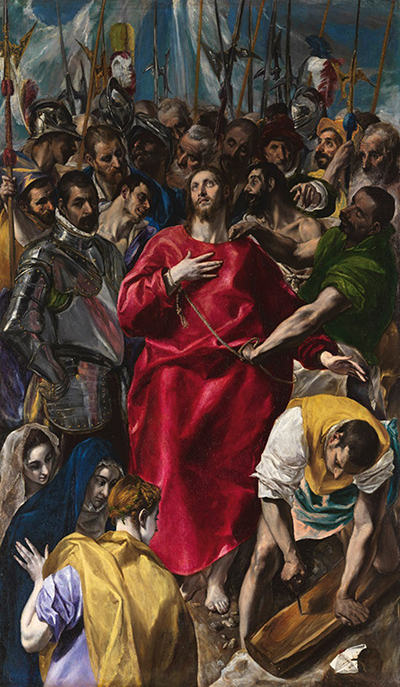The Disrobing of Christ is one of El Greco’s most well-recognised paintings. He began work on it in the summer of 1577 and completed it in the Spring of 1579.
It was commissioned by the Cathedral of Toledo to hang on the high altar of its vestry. It remains there today, though it was recently taken by the Prado in Madrid for conservation work, and subsequently shown in their galleries for a short time, before being returned to the cathedral.
This painting depicts the moments of preparation before Christ’s crucifixion, an unusual subject for Western art at the time. Christ is surrounded by a crowd of executioners who rise above him into the background clad in dark colours, giving a sense of his oppression.
On the right, a man restrains Christ with a rope around his neck and is about to rip his robe off. Behind him, two men argue over which of them will keep his clothing, while another points at him disdainfully. A man in the foreground is shown preparing the cross on which Christ will be hung by drilling a hole in the bottom where his feet will be nailed. The three Marys are painted in the bottom left corner, clearly upset by what is happening. The man on Christ’s left, a soldier, is depicted wearing what appears to be sixteenth-century Toledan armour, suggesting El Greco may have included him as a contemporary portrait.
Christ, in the centre of the painting, contrasts sharply with the crowd surrounding him. Despite the chaos around him, he is depicted as the picture of serenity and grace as he looks up to the heavens. The bright red of his robe is also a stark juxtaposition against the dark colours of the crowd looming behind him.
This use of bold colour in painting Christ, as well as the painting of the crowd behind him as rows of stacked heads, is reminiscent of Byzantine art. Colour was also crucial to the Venetian style of painting El Greco had previously studied. The slightly odd perspective and twisting postures of the figures, on the other hand, are influenced by the Mannerist style.
El Greco secured the commission of this piece through his friendship with the dean of the cathedral, but upon its completion there was a dispute between El Greco and the cathedral’s representatives. They disapproved of the inclusion of the three Marys in the foreground, as they weren’t said to be present by the gospels. They also disliked the rising of the crowd behind Christ, as it placed the executioner’s heads above his. El Greco’s failure to remove these controversial elements was the source of the disagreement and he had no choice but to seek legal arbitration. His appraiser valued the painting at 950 ducats but after the arbitration he was awarded only 350 as payment for not removing the contested figures.
In spite of this conflict with his clients, The Disrobing of Christ enjoyed great success. There are more than 17 known recreations of this painting, including two smaller copies generally considered to have been created by El Greco himself.
Unfortunately, this was not the only piece El Greco painted that left its commissioner unsatisfied. El Greco’s ambition when moving to Toledo was to win the favour of King Philip II, who was constructing the palace El Escorial but having trouble finding artists to commission. While El Greco eventually painted two pieces for Philip, the king disliked them and neglected to give him any further commissions. As a result, El Greco spent the rest of his life painting in Toledo, where he had a reputation as a great artist, founded largely on the success of this piece.




